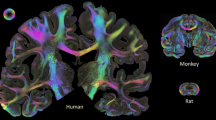Abstract
The television image-splitting technique was used to study the influence of arterialpCO2 and blood pressure on the dilatatory response of pial arterioles to topically applied adenosine in chloralose anaesthetised cats. At normocapnia (pCO2≃35 mm Hg) 10−5 adenosine caused pial arteriole dilatation of 29.2 ±2.7% (S.E.M.). This was significantly reduced to 14.5±1.6% (P<0.001) atpCO2 25 mm Hg and to 8.5±1.6% (P<0.001) atpCO2 48 mm Hg. Lowering the blood pressure to 65–85 mm Hg had no significant effect on the adenosine response, but raising the blood pressure to 140–160 mm Hg significantly reduced the adenosine response to 22.1±1.8% (P<0.05). The response was independent of vessel size except at hypertension where vessels<150 μm were significantly more reactive than the larger vessels (P<0.01). These results indicate that adenosine induced vasodilatation of pial arterioles shows little change in the face of alterations in vessel tone induced by altering blood pressure, but is markedly decreased by the combination of changing perivascular pH and vascular resistance through moderate changes in arterialpCO2. The importance of these results in assessing the role of adenosine as a cerebral vasodilator is discussed.
Similar content being viewed by others
References
Berne RM, Rubio R, Curnish RR (1974) Release of adenosine from ischemic brain. Circ Res 35:262–271
Farrar JK, Jones JV, Graham DI, Strandgaard S, MacKenzie ET (1976) Evidence against cerebral vasospasm during acutely induced hypertension. Brain Res 104:176–180
Fog M (1937) Cerebral circulation. The reaction of the pial arteries to a fall in blood pressure. Arch Neurol Psychiat 37:351–364
Fog M (1938) Relationship between blood pressure and tone regulation of the pial arteries. J Neurol Psychiat 1:187–197
Fog M (1939) Cerebral circulation. II. Reaction of pial arteries to increase in blood pressure. Arch Neurol Psychiat 41:260–268
Gotoh F, Muramatsu F, Fukuuchi Y, Amano T (1973) Dual control of cerebral circulation. Separate sites of action in vascular tree in autoregulation and chemical control. Stroke 4: Abstr. 327
Heuser D, Knabe U, Gebert G, Betz E (1971/72) Reactions of pial vessels during variation of local perivascular ionic composition of the CSF. Eur Neurol 6:96–99
Kontos HA, Wei EP, Raper AJ, Patterson JL Jr (1977) Local mechanism of CO2 action on cat pial arterioles. Stroke 8;226–229
Kontos HA, Wei EP, Navari RM, Levasseur JE, Rosenblum WI, Patterson JL Jr (1978) Responses of cerebral arteries and arterioles to acute hypotension and hypertension. Am J Physiol 234:H371-H383
Kuschinsky W, Wahl M, Bosse O, Thurau K (1972) Perivascular potassium and pH as determinants of local pial arterial diameter in cats. A microapplication study. Circ Res 31:240–247
Kuschinsky W, Wahl M (1975) Alpha-receptor stimulation by endogenous exogenous norepinephrine and blockade by phentolamine in pial arteries of cats. Circ Res 37:168–174
Kuschinsky W, Wahl M (1980) Letter to Editor. Microvasc Res (in press)
Lassen NA (1977) Brain extracellular pH: The main factor controlling cerebral blood flow. Scand J Clin Lab Invest 22:226–229
MacKenzie ET, Strandgaard S, Graham DI, Jones JV, Harper AM, Farrar JK (1976) Effects of acutely induced hypertension in cats on pial arteriolar calibre, local cerebral blood flow, and the blood-brain barrier. Circ Res 39:33–41
MacKenzie ET, Young AR, Stewart M, Harper AM (1977) Effect of serotonin on cerebral function, metabolism and circulation. Acta Neurol Scand (Suppl 64) 56:76–77
MacKenzie ET, Farrar JK, Fitch W, Graham DI, Gregory PC, Harper AM (1980) Effects of haemorrhagic hypotension on the cerebral circulation. I. Cerebral blood flow and pial arteriolar calibre. Stroke 10:711–718
Navari RM, Wei EP, Kontos HA, Patterson JL Jr (1978) Comparison of the open skull and cranial window preparations in the study of the cerebral microcirculation. Microvasc Res 16:304–315
Raper AJ, Kontos HA, Patterson JL Jr (1971) Response of pial precapillary vessels to changes in arterial carbon dioxide tension. Circ Res 28:518–523
Rehncrona S, Nordstrom C-H, Siesjö BK, Westerberg E (1977) Adenosine in rat cerebral cortex during hypoxia and biculline-induced seizures. Acta Neurol Scand (Suppl 64) 56:220–221
Rubio R, Berne RM, Bockman EL, Curnish RR (1975) Relationship between adenosine concentration and oxygen supply in rat brain. Am J Physiol 228:1896–1902
Schneider W, Wahl M, Kuschinsky W, Thurau K (1977) The use of microelectrodes for measurement of local H+ activity in the cortical subarachnoid space of cats. Pflügers Arch 372:103–107
Wahl M, Kuschinsky W, Bosse O, Thurau K (1973) Dependency of pial arterial and arteriolar diameter on perivascular osmolarity in the cat. A microapplication study. Circ Res 32:162–169
Wahl M, Kuschinsky W (1976a) The dilatatory action of adenosine on pial arteries of cats and its inhibition by theophylline. Pflügers Arch 362:55–59
Wahl M, Kuschinsky W (1976b) Influences of pH on adenosine-induced dilatations of pial arteries. In: Betz E (ed) Ionic actions on vascular smooth muscle, Springer, Berlin, Heidelberg, New York, pp 141–144
Wahl M, Kuschinsky W (1977) Dependency of the dilatatory action of adenosine on the perivascular H+ and K+ at pial arteries of cats. Acta Neurol Scand (Suppl 64) 56:218–219
Wahl M, Kuschinsky W (1980) Unimportance of perivascular H+ and K+ activities for the adjustment of pial arterial diameter during changes of arterial blood pressure in cats. Pflügers Arch (in press)
Wolff HG, Lennox WB (1930) Cerebral circulation XIII. Effects on pial vessels of variations in the oxygen and carbon dioxide content of the blood. Arch Neurol Psychiat 23:1097–1120
Author information
Authors and Affiliations
Additional information
This study was supported by the Medical Research Council of Great Britain. D. P. J. Boisvert was supported by a Medical Research Council of Canada Fellowship
Rights and permissions
About this article
Cite this article
Gregory, P.C., Boisvert, D.P.J. & Harper, A.M. Adenosine response on pial arteries, influence of CO2 and blood pressure. Pflugers Arch. 386, 187–192 (1980). https://doi.org/10.1007/BF00584207
Received:
Accepted:
Issue Date:
DOI: https://doi.org/10.1007/BF00584207




